Tag along with Comet Iwamoto (C/2018 Y1) as it scurries from Virgo to Leo in the coming week. It's already 7th magnitude and visible in binoculars from a dark sky.
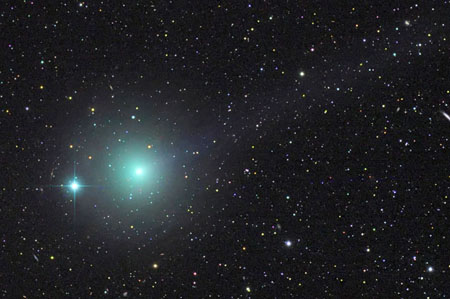
Rolando Ligustri
Having a comet meet expectations is saying something. I'm happy to report that Comet Iwamoto (C/2018 Y1) is making good on its campaign promises. Currently at magnitude 7 and visible in binoculars, it recently transitioned from the morning to the evening sky.
On Feb. 6, the comet rises around 9:30 p.m. local time in western Virgo and becomes well-placed in the southeastern sky by 11 o'clock. Over the next 5 nights, C/2018 Y1 will pole vault from Virgo to the Sickle of Leo and stand ready for your telescope or binoculars as early as 8 p.m.
The comet passes perihelion on Feb. 6 and then swings nearest Earth on the 12th at a distance of just 0.3 a.u. It should brighten a bit more to magnitude 6.5 before fading back to 9 by early March and magnitude 11–12 when April showers bring May flowers. Observers describe the comet as large and diffuse with a somewhat more condensed inner coma. Estimates of the coma size range from 20 to 30 arcminutes, or nearly the size of the full Moon.
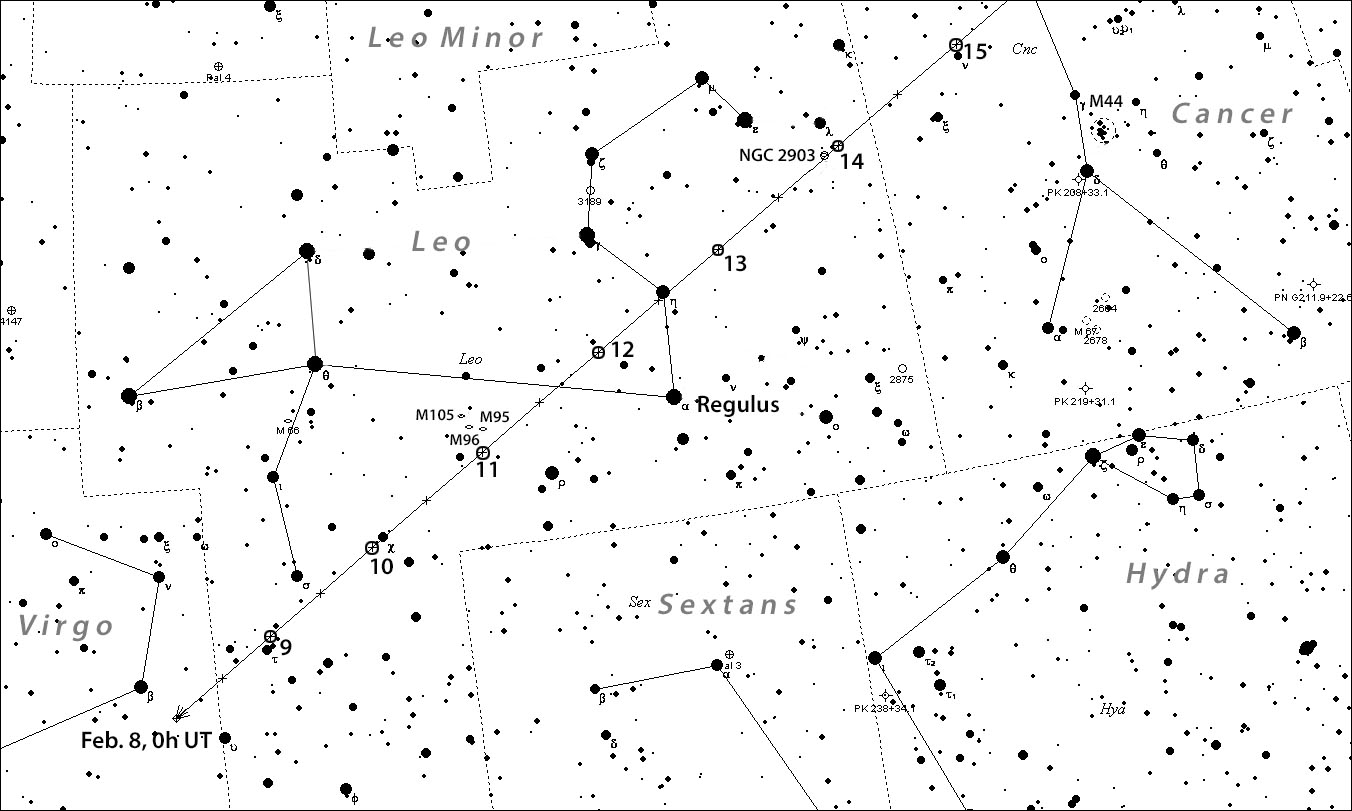
Chris Marriott with additions by the author
When it comes to large, diffuse objects, sky darkness can make a significant difference in a magnitude estimate. Those who see a larger coma will estimate a brighter magnitude than someone viewing from the suburbs, where only the inner core of the comet may be visible. Fortunately, C/2018 Y1 will stand high in the southern sky from mid-northern latitudes around the time of peak brightness.
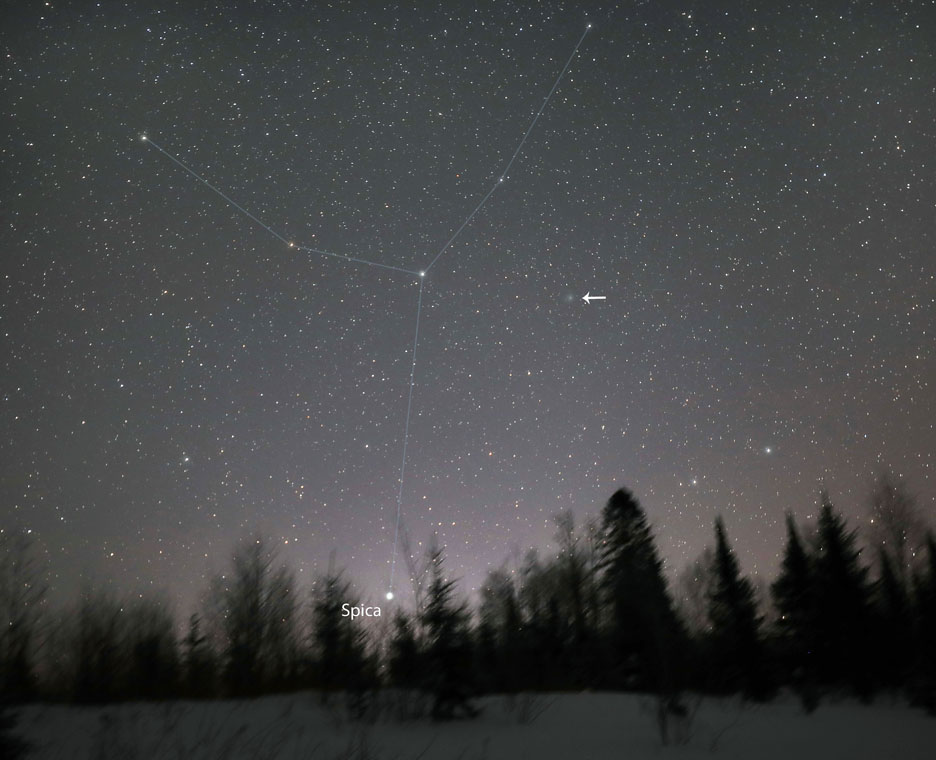
Bob King
When you look for the comet, expect to see a fuzzy glow similar to how Comet 46P/Wirtanen appeared earlier this year but fainter. Wirtanen never showed a tail in my binoculars, but Iwamoto may. At least one observer reported a faint, 1.5-degree-long tail pointing northwest on Feb. 6 using only a 45-mm monocular. I observed it in 10×50 binoculars about 20° high in dark sky on Feb. 5.2 UT and saw a dim patch of haze 20′ across with a slightly brighter center. I wouldn't say it was bright, but I found the comet quickly and easily.
The view through the 10-inch reflector at low magnification was impressive. The big coma looked like a cloud of condensed breath with a hint of blue coloration. The inner core appeared dense with a faint, near-stellar nucleus glimpsed at 160×. The comet's degree of condensation was 4 on a scale of 0 (no compaction) to 9 (stellar appearance). A Swan Band filter brightened up the coma relative to the sky background, indicating emission from carbon-enriched gases.
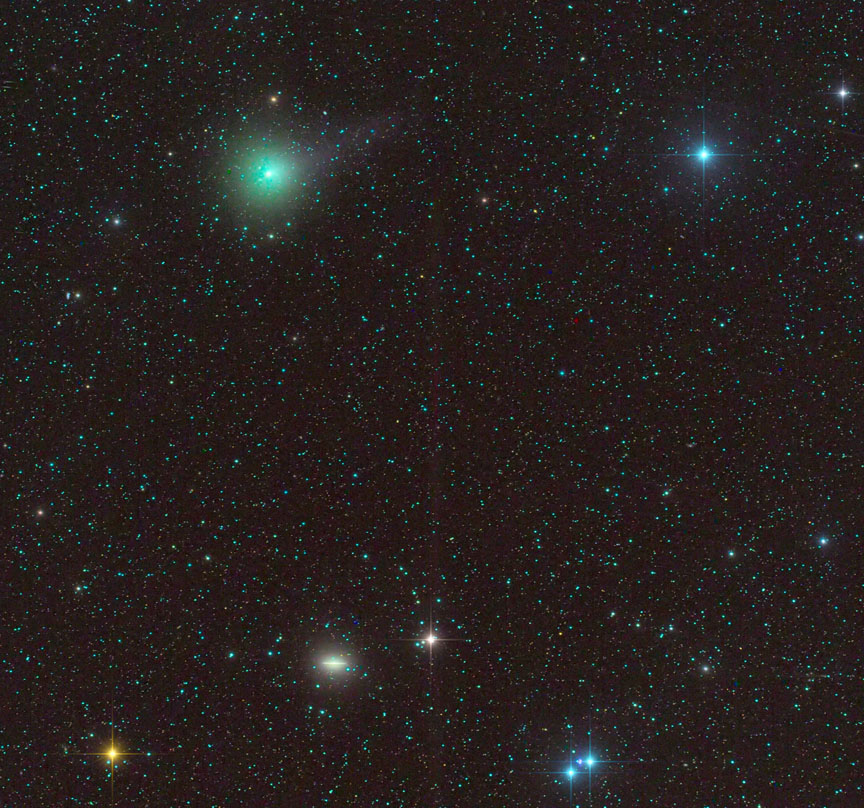
Rolando Ligustri
Comet Iwamoto gallops across galaxy country during the next week — moving nearly 7.5° per day on Feb. 10 and 11 — and makes two memorable galactic pit stops perfect for astrophotographers. The first occurs on the night of Feb. 10 when it glides about a degree west-southwest of the M95-M96 duo.
Its next encounter will be even more exciting both photographically and visually. On Feb. 13 around 21.3 h UT (4:20 p.m. EST), Comet Iwamoto will pass just 3.5 arcminutes south of the 9.7-magnitude galaxy NGC 2903 at the tip of Leo's Sickle. Given the galaxy's dimensions of 12′ × 6′ and a coma expected to be 30′ or larger, the comet should completely smother the galaxy! How often do we get to see a bright galaxy through a comet's veil?
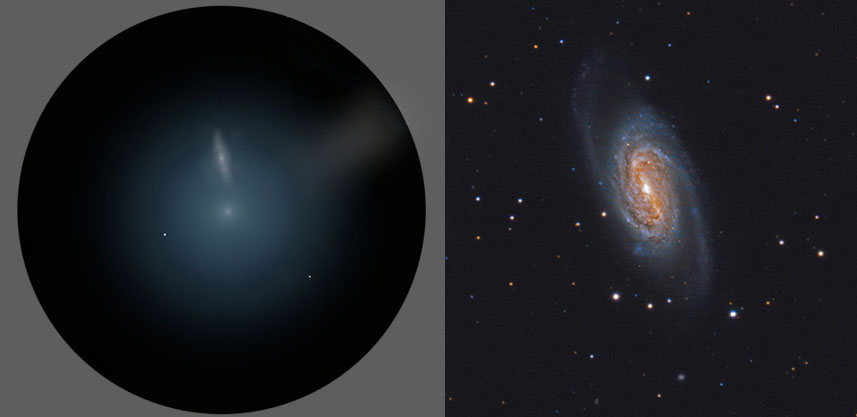
Bob King (left), Hunter Wilson
Observers in Europe, Africa and Asia will get a great view of the close conjunction, but because the comet moves so swiftly at this time, their separation will have widened to 50′ at nightfall for the East Coast and 2° for the West Coast on the evening of Feb. 13.
Comet observers always keep track of the Moon, knowing its power to seriously diminish a broom star's splendor. Here we're in luck. Although the Moon will be waxing in the coming nights, it won't be a bother until about the 12th, when it reaches first-quarter phase. Even that's tolerable. Purists can still find black sky by observing after moonset: The last moonless morning to see the comet at its prime will be Feb. 16. Good luck all!
 22
22








Comments
Rod
February 6, 2019 at 2:22 pm
Good comet charts. I will try and view Friday night and early Saturday morning and Saturday night in Maryland. Skies should be much clearer and cooler temps down in mid to low 20s F. Early Saturday morning, the comet will transit in my area near 0150 EST, up about 59 degrees altitude and 180 degrees azimuth, well placed for easy viewing in Leo. I plan to use my binoculars and 90-mm refractor with 14-mm eyepiece that gives 71x with 1-degree true FoV. Looking forward to another comet observation.
You must be logged in to post a comment.
Bob KingPost Author
February 6, 2019 at 5:30 pm
Hey Rod,
Let us know your impressions when you get a good look. Thanks!
You must be logged in to post a comment.
Kye
February 6, 2019 at 3:25 pm
Nice chart, but no comet! ???
You must be logged in to post a comment.
Bob KingPost Author
February 7, 2019 at 8:32 am
Hi Kye,
I'm not sure what you mean. Did you look for it and not find the comet?
You must be logged in to post a comment.
Joe Stieber
February 7, 2019 at 12:38 am
Bob, I hate to be a pain, but I think this new chart is off. The positions on it closely match those shown by my copy of SkyTools (with the latest element updates), but both the chart and SkyTools differ from the positions shown by SkySafari (also with the latest elements). So far, on the four occasions I’ve observed Iwamoto (Jan 12, Jan 30, Feb 3 and Feb 5, 2019), SkySafari has shown an accurate position and SkyTools has been off.
In fact, Iwamoto’s position in your picture from Feb 5 at 12:15 am CST (nice shot) matches with SkySafari, while SkyTools has Iwamoto three-quarters of a degree to the west. I recognize the star field because I was looking there a couple of hours later.
As a result, there’s a big difference in the times shown for Iwamoto crossing NGC 2903. SkyTools, and your article, have it crossing about 12 UT or 7:00 am EST on Feb 13. In contrast, SkySafari shows it crossing NGC 2903 about 4:30 pm EST, or 21:30 UT, 9.5 hours later. At 7 am EST, SkySafari has the comet 2.8° east of the galaxy.
BTW, I saw Iwamoto on Feb 5 with 15x56 binoculars from a suburban location in a hazy sky, albeit, at the threshold of visibility. Shortly before, from my home in a denser suburb (a bit more light pollution), I could not see it with the binoculars. On Feb 3, under dark skies looking south over the Delaware Bay, Iwamoto was easy with the 15x56s.
You must be logged in to post a comment.
Bob KingPost Author
February 7, 2019 at 8:29 am
Hi Joe,
I double-checked these again this morning, and the positions and dates are accurate. All my positions are UT. They SkyMap positions are in agreement with Stellarium. Not sure what might give the
error on the programs you mentioned.
You must be logged in to post a comment.
Rod
February 7, 2019 at 9:07 am
Bob, what version of Stellarium do you use? I noticed too slight differences in the comet's ephemeris and projected orbit, thanks.
You must be logged in to post a comment.
Joe Stieber
February 11, 2019 at 12:09 pm
I downloaded the element set again this morning, Feb 11, 2019 (probably the fourth time I’ve done so), and SkyTools is now showing the correct position for Iwamoto.
You must be logged in to post a comment.
Bob KingPost Author
February 11, 2019 at 8:26 pm
Tell me Joe, have you ever had to update an element set this frequently?
You must be logged in to post a comment.
Joe Stieber
February 11, 2019 at 11:51 pm
No. For whatever reason, this has been an unusual case as I have seen many dozens of comets in the past, and SkyTools always provided an accurate position with the routine element updates. I used the manual “MPC Observable” element download (from the Minor Planet Center) several times before today’s download got it right, so I guess it’s the MPC rather than SkyTools that was off.
You must be logged in to post a comment.
Rod
February 7, 2019 at 10:17 am
Bob, disregard. I got the latest C/2018 Y1 elements uploaded now, Stellarium 0.18.3. I had to read the User Guide 🙂
You must be logged in to post a comment.
Bob KingPost Author
February 7, 2019 at 10:53 am
Hi Rod and Joe,
Rod, I use Stellarium 0.18.3. I just updated the orbital elements for C/2018 Y1 yet again and indeed it has shifted position! I have re-cast the chart and updated other details. Joe -- thanks again for noticing the discrepancy. Much appreciated.
You must be logged in to post a comment.
fif52
February 7, 2019 at 7:24 pm
Another question on comet mass? Sosa and Fernandez's paper on 'masses of long period comets' includes this but are the details available to complete? Do you have a theory on why some comets have long and some have short orbits. And was this spotted before? guessing a solid icy slightly elongated mass nucleui and pressurized plasma ionized gas tail.
You must be logged in to post a comment.
Bob KingPost Author
February 8, 2019 at 10:26 am
fif52,
Short period comets generally originate from the Kuiper Belt beyond Neptune. The Halley-family have orbital periods between 20 and 200 years. The Jupiter-family have periods of 20 years and less. Their orbits have been shaped by Jupiter's gravitational pull. Long period comets originate from the Oort Cloud, making C/2018 Y1 a long-period object.
You must be logged in to post a comment.
Rod
February 7, 2019 at 11:33 pm
fif52, Starry Night shows the comet mass is close to 6E+15 kilograms with an orbital period a bit longer than 1362 years. This is indeed a long period comet 🙂
You must be logged in to post a comment.
Jim-Gasser
February 9, 2019 at 11:58 pm
Just nabbed Iwamoto as my 26th lifetime comet, from Monclova Twp, Ohio (near Toledo). This was a fairly difficult sighting for me in 20 x 80 binoculars, in my suburban and somewhat light polluted sky. I have a dark backyard, but mall lights aren't all that far away! A small hazy patch, but easily confirmed with averted vision and by slightly nudging the binoculars to detect a bit of motion. Sky condition was steady but perhaps just a possible hint of haze in the air. I'm sure my challenges are largely due to light pollution for such a relatively diffuse object. I will continue to track it in the days to come, weather permitting.
You must be logged in to post a comment.
Bob KingPost Author
February 10, 2019 at 2:21 pm
Excellent, Jim! Especially given your location. I also saw it this weekend again from home in 8x40 binoculars. Because it was higher up it was easier than a week ago.
You must be logged in to post a comment.
Joe Stieber
February 10, 2019 at 7:58 pm
I saw Iwamoto again last night (Feb 9/10, 2019), using 15x56 binoculars under a clear sky, initially, around 11:20 pm EST from a suburban site. It was pretty faint, but some of the coma was overlapping the magnitude 7.2 star, HD 95848 (near Chi Leo), which must have interfered with the view a bit. Then I was off to the dark New Jersey Pines. From there, starting at 12:20 am, the comet was obvious in the 15x56s, even though it looked large and somewhat low in surface brightness. I didn’t notice any color and there was no tail visible, but its movement was evident in a short time span.
You must be logged in to post a comment.
Rod
February 10, 2019 at 8:32 pm
Joe Stieber, your report is a good description, I observed early this morning near 0200 EST in Maryland using 10x50 binoculars. *It was pretty faint*, good description. My view early this morning was similar to my binocular view of 21P/Giacobini-Zinner in early September last year, another 7th magnitude comet but that comet I did observe using my telescope and that was a nice view. Skylive.com reports the apparent magnitude was +6.8 or +6.7 early this morning for C/2018 Y1. Comet transit in Leo this morning near 0150 EST or 0650 UT for my location with altitude above 57 degrees. Now some wintery mix with clouds is back in my area so perhaps a telescope view will come later. I did not stay out long early this morning, temp was 16F and I went back in for some sleep time 🙂 This is my C/2018 Y1 comet adventure for today 🙂
You must be logged in to post a comment.
Joe Stieber
February 11, 2019 at 3:18 am
Rod — I would emphasize that it was “pretty faint” from the suburban location, due to the light pollution there as well as the effect of being over the seventh magnitude star (but a little better as it moved off the star). By time I got to the dark Pines, Iwamoto had moved well away from that star, so it was no longer a factor, and by being “obvious,” I mean that it appeared relatively bright against the now-darker background sky (due to the reduced light pollution in the Pines, specifically, Wharton State Forest, NJ). BTW, I have a snapshot of Iwamoto on my web page, hotlinked off my name next to the icon.
You must be logged in to post a comment.
Dave Mitsky
February 11, 2019 at 1:22 am
I arrived at the Astronomical Society of Harrisburg's Naylor Observatory late Saturday night. My primary goal was to observe Comet C/2018 Y1 (Iwamoto) in Leo, which was rather easy using 12x50 and 15x70 binoculars. The comet was located northwest of a seventh-magnitude star (HIP 54057, HD 95848) that lies northwest of fifth-magnitude star Chi Leonis (63 Leonis). I also viewed it through an 105mm f/4.2 Edmund Scientific Astroscan at 22, 26, and 44x, an 8" f/6 Hardin Dob at 34, 48, 60, and 120x, and a 12.5" f/6.5 Cave Astrola equatorial Newtonian at 59, 83, and 103x.
Comet Iwamoto's coma was diffuse and fairly large. There seemed to be a bit of condensation at higher magnifications through the 12.5" Cave. I didn't notice any color or a tail but the coma appeared to be somewhat asymmetric.
You must be logged in to post a comment.
Steven-Rudnick
February 11, 2019 at 10:37 pm
It would be nice if the conet were shown on the interactive sky chart.
You must be logged in to post a comment.
You must be logged in to post a comment.